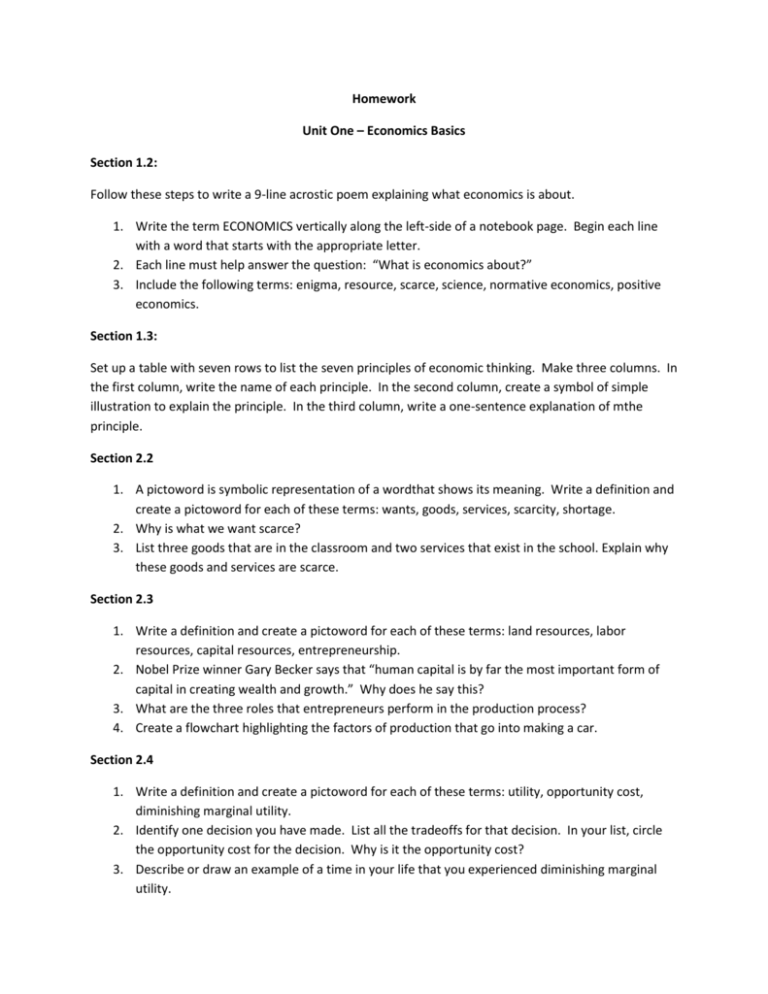Basics Homework (TCI)
advertisement

Homework Unit One – Economics Basics Section 1.2: Follow these steps to write a 9-line acrostic poem explaining what economics is about. 1. Write the term ECONOMICS vertically along the left-side of a notebook page. Begin each line with a word that starts with the appropriate letter. 2. Each line must help answer the question: “What is economics about?” 3. Include the following terms: enigma, resource, scarce, science, normative economics, positive economics. Section 1.3: Set up a table with seven rows to list the seven principles of economic thinking. Make three columns. In the first column, write the name of each principle. In the second column, create a symbol of simple illustration to explain the principle. In the third column, write a one-sentence explanation of mthe principle. Section 2.2 1. A pictoword is symbolic representation of a wordthat shows its meaning. Write a definition and create a pictoword for each of these terms: wants, goods, services, scarcity, shortage. 2. Why is what we want scarce? 3. List three goods that are in the classroom and two services that exist in the school. Explain why these goods and services are scarce. Section 2.3 1. Write a definition and create a pictoword for each of these terms: land resources, labor resources, capital resources, entrepreneurship. 2. Nobel Prize winner Gary Becker says that “human capital is by far the most important form of capital in creating wealth and growth.” Why does he say this? 3. What are the three roles that entrepreneurs perform in the production process? 4. Create a flowchart highlighting the factors of production that go into making a car. Section 2.4 1. Write a definition and create a pictoword for each of these terms: utility, opportunity cost, diminishing marginal utility. 2. Identify one decision you have made. List all the tradeoffs for that decision. In your list, circle the opportunity cost for the decision. Why is it the opportunity cost? 3. Describe or draw an example of a time in your life that you experienced diminishing marginal utility. Section 2.5 1. Why do economists use the Production Possibilities Frontier? 2. Use the information below to create a graph: Point Wheat (pounds) A 0 B 300 C 500 D 700 E 800 Chips 800 750 700 500 0 What is the opportunity cost of increasing wheat production by 200 pounds by moving from point B to point C? What is the opportunity cost of increasing wheat production by 200 pounds by moving from point C to point D? Why might the opportunity cost vary so greatly? Section 3.2 1. For each of the fundamental economic questions, explain why it is important for society to answer that question. 2. Rank the six economic goals from most important to least important. Justify your answers. Section 3.3 Make a 4-column table with four rows. In the first column, list the four economic systems: Traditional, Ancient Command economy, Market economy, Modern Command economy. In the second column, make a symbol for each. In the third column, record the key features of each economic system, and in the last column, write down which goals each economic system emphasizes. Section 3.4 1. What are the three roles of the government in a mixed economy? For each role, explain whether you view this involvement as positive or negative, and why. 2. Create a spectrum like the one below. Choose four or five countries and place them on that spectrum, with one sentence justifying your placement. Free Mostly Free Moderately Free Mostly Unfree Repressed Section 3.5 List the seven key characteristics of the American free-enterprise system. Write a sentence explaining each characteristic. Also, give one example of where you have seen this characteristic in our economy.




